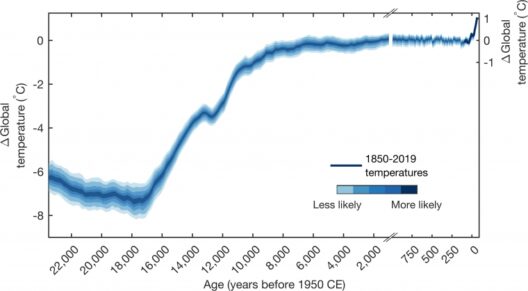China’s coastal regions represent a paradox of breathtaking beauty and profound vulnerability, trapped in the relentless grip of global warming. The nation boasts an extensive coastline, stretching over 14,500 kilometers, making it one of the most significant coastal territories in the world. This geographic wealth, however, is intricately linked to issue of rising sea levels—a phenomenon closely tied to climate change. Addressing this coastal conundrum requires an examination of various factors including socio-economic implications, ecological repercussions, and potential adaptive strategies.
One of the most acute concerns regarding rising sea levels is the direct threat they pose to densely populated coastal cities such as Shanghai, Guangzhou, and Tianjin. These metropolises are not only economic hubs but also cultural epicenters, attracting millions of residents and international tourists each year. As global temperatures continue to rise, the polar ice caps and glaciers melt at an alarming rate, contributing to elevating sea levels. Projections suggest that by the end of this century, sea levels could rise between 0.5 and 2 meters, depending on various emission scenarios. This impending threat creates existential dilemmas for urban planners, as the very foundations of these cities may be at risk.
Moreover, the consequences extend far beyond urban infrastructure. China’s vast coastal areas are home to vital ecosystems, including mangroves, wetlands, and coral reefs. These fragile ecosystems play a crucial role in coastal protection, acting as natural barriers against storm surges and erosion while providing habitat for a myriad of wildlife. Rising sea levels can lead to increased salinity in coastal waters, adversely affecting freshwater sources and disrupting the ecological balance. When salty seawater permeates freshwater supplies, agricultural yields dwindle, altering the livelihoods of farmers reliant on consistent access to clean water. Such repercussions resonate deeply within the broader framework of food security, underscoring the interconnectedness of climate stability and human sustenance.
An often overlooked but significant aspect of the sea-level rise challenge is its profound socio-economic implications. In coastal provinces like Jiangsu and Zhejiang, a considerable portion of the population resides below current mean sea levels. Should the worst projections of sea level rise materialize, millions could be displaced, sparking a humanitarian crisis of unprecedented scale. Rapid urbanization has led to unregulated development in these areas, exacerbating their vulnerability. The loss of land due to flooding not only uproots communities but also displaces industries, leading to economic upheaval that could reverberate throughout the national economy.
China’s government has recognized the pressing nature of this issue, implementing strategies aimed at bolstering coastal resilience. Investment in advanced engineering projects, such as sea walls and flood barriers, has intensified. Yet, while these initiatives are necessary, they often provide only a temporary reprieve. Environmental degradation, exacerbated by climate change, necessitates a paradigm shift towards sustainable development. This approach encompasses not only infrastructural resilience but also the preservation of natural systems that can buffer against the impacts of rising seas.
Additionally, proactive adaptation measures must include integrated coastal zone management (ICZM). This holistic strategy prioritizes collaboration among various stakeholders—including government entities, local communities, and environmental organizations. Through such collaboration, China can establish guidelines that promote responsible land use and coastal conservation. Strengthening policies to reduce greenhouse gas emissions remains essential; without addressing root causes, efforts to adapt will be compromised.
Internationally, the conundrum of rising sea levels transcends China’s borders. The country is a significant player in global climate negotiations, often finding itself at the nexus of discourse on sustainable practices and emission reductions. As one of the world’s largest emitters of carbon dioxide, China’s commitment to climate action bears implications not only for its citizens but for global environmental health. The endeavor to tackle sea-level rise must be viewed through an international lens, as the repercussions of unchecked climate change are universally felt. Thus, international cooperation must ensue, whereby technology transfer and financial aid can empower vulnerable nations, including China, to fortify their coastal defenses.
China’s coastal conundrum encapsulates myriad complexities—rural and urban, economic and ecological, local and global. These intertwined issues demand multifaceted solutions that remain adaptable to the evolving climate landscape. As China’s vulnerability to rising sea levels grows, so does the urgency to protect its coastlines and the millions who depend on them. This challenge stands not merely as an environmental crisis but as an opportunity for innovative leadership in climate resilience. In acknowledging the interconnectedness of natural and human systems, China can pioneer pathways that reflect a commitment to sustainability, equity, and a secure future for generations to come.
To encapsulate, China finds itself at a crossroads. The beauty of its coastal territories is juxtaposed with the stark reality of climate-induced threats. By addressing the root causes of global warming, prioritizing sustainable development, and fostering international collaboration, China can work towards mitigating the impacts of rising sea levels. This effort not only protects its own populace but also contributes to the larger goal of global environmental stewardship, establishing a legacy that encompasses resilience and responsibility.








